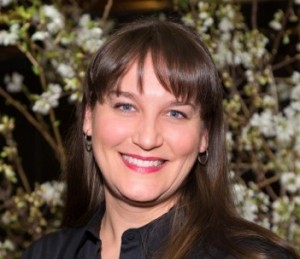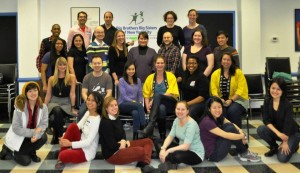
Members of the JET Alumni Association of New York volunteering in the annual Japan-a-Mania community event with Big Brothers Big Sisters of New York City, January 2014. (Courtesy of Monica Yuki)
By Eden Law (Fukushima-ken, 2010-11) for JQ magazine. Eden is JETAA New South Wales‘s webmaster, meaning he is the voice on all the online and social media for the Sydney-based chapter like Twitter, Instagram (both @jetaansw) and Facebook. Outside of JETAA, he doesn’t exist, and is merely a concept of a shadow of a dream of an enigma, wrapped in mystery and served with a side of salad.
Introduction
The following is a shamelessly biased opinion: Being a member of JETAA is fantastic. One gets to help organise and be involved in events and projects that reach the general public here in Sydney (like the Japan Festival), hang out with a great group of like-minded people that know all the best Japanese places to eat, drink and be merry, and who are rarely inhibited in any karaoke session. There is ample opportunity to new people constantly, both inside and outside that chapter’s home city’s J-community, so in a way, the JET experience never truly ends.
That’s a personal assessment of what it’s like being a member of JETAA, the alumni association for former JETs. JETAA chapters exist all over the world from where the JET Programme has drawn its recruits. They give former JETs a way to connect with their local J-community and like-minded peers, and are essentially a non-profit social organisation with a Japanese cultural bent. And because JET is made up of a diverse group of people from all walks of life, JETAA chapters have great potential as a resource with links in government, business, education, academia and social networks.
But it can’t be denied that many chapters struggle with visibility or relevancy, in attracting members to events or to join their committees. The last point is especially important, as new members help to keep the organisation dynamic and active. And while the reasons for this are different for every situation, some similar and salient points can be discerned, notably from online forum comments (like LinkedIn). While a comprehensive discussion can probably fill a volume or ten, this article will nevertheless discuss these points.
So what does JETAA have to deal with?
JapaneseLondon.com April Newsletter
 Here’s a link to the latest JapaneseLondon.com April Newsletter. This wonderful site is run by JET alum Vanessa Villalobos.
Here’s a link to the latest JapaneseLondon.com April Newsletter. This wonderful site is run by JET alum Vanessa Villalobos.
http://us5.campaign-archive2.com/?u=7bc6ccc938e02760a959b1d91&id=60f2abc5ca&e=d52cd058ae
Japan Times features JET alum Matthew Cook and his work with Osaka’s English Reformation Project Team
****************************
Very nice article on JET alum and former AJET Chair Matthew Cook (Osaka-fu, 2007-12) about his path from JET to becoming an agent of change for the Japanese English education system through is unique role with Osaka Prefecture’s Board of Education. Matt is also the founder of the Kansai JET Alumni group. FYI, you can also click here for a recent JQ profile of Matthew Cook by JETAA New South Wales‘ Eden Law (Fukushima-ken, 2010-11) .
Changing the system starts by challenging it
BY TERU CLAVEL
Just seven years after first participating in the JET program in Osaka, Matthew Cook from Danville, Virginia, is making great strides as a pioneer of English-language education reform in Japan. Having never previously been to an Asian country, Cook is now one of seven members of Osaka’s groundbreaking English Reformation Project Team, having been appointed by Osaka superintendent Toru Nakahara in 2013. With an unswerving commitment to English-language education and a little luck, Cook’s efforts may pave the path for Japan’s next generation of global leaders.
Cook applied to the JET (Japan Exchange and Teaching) program because it was “the most lucrative, stable and safe way to get to Japan.” Having run his own karate dojo in the United States, he felt the need to gain a deeper understanding of the Japanese culture behind it. However, Cook was waitlisted and needed to make a snap decision when he was offered a position within a month of the JET start date. “I had totally assumed that I wasn’t going to get in,” he says.
Cook’s initial placement was less than ideal, though. He was forewarned that the Osaka junior high school to which he was assigned might be challenging, but he was not prepared for the “few students who were stopping class altogether, violence in the classroom or kids getting up and leaving.” Read More
JQ Magazine: From JET to Japan-Related Jobs – New York Edition
By Brett Rawson (Akita-ken, 2007-09) for JQ magazine. Brett is a writer, translator, and volunteer. He currently lives in New York, where he is pursuing an MFA in creative writing at The New School and is the professional development chair for the JET Alumni Association of New York. If you have job opportunities for JET alums, an interest in presenting at JETAANY’s annual Career Forum, or want to collaborate on professional endeavors, contact him at career@jetaany.org.
If you listen closely, the age-old JET adage every situation is different can be heard echoing around the world. This is because it’s said so frequently, but that’s because there is truth to the takeaway: Paths to JET, experiences in Japan, and adventures thereafter run in every direction. But when the stories sit side by side, a greater context for, character of and meaning to the program and participants, takes solid shape.
Below are features on three New York City-based JET alumnae. Each carved a unique path to, on, and from the program, but they share one incredible thing in common: they are working at three of the largest Japan-related non-profit organizations in the world. For those interested in following in their professional footsteps, JQ would like to introduce to you them and share their advice about entering the world of Japan-related non-profits.
Meet Christy Jones, Director of Special Events at Japan Society
ALT, Shimabara-shi, Nagasaki-ken, 1995-98
Born and raised in Upstate New York, Christy received a degree in cultural anthropology and a certificate in Asian and African Languages and Literature from Duke University. That was the closest she could get to a degree in Japanese, but it wasn’t the closest she got to Japan: Her junior year, she studied abroad at Kansai Gaidai University in Osaka. But that stint didn’t quite quench her thirst for the cuisine and culture. The following fall, she applied to JET, got accepted, and returned to Japan—but this time for three years.
Christy served as an ALT at an academic high school in Shimabara-shi in Nagasaki. Thinking back, she has very fond memories of her time on JET: “As this was the pre-Internet era, I didn’t know much about Nagasaki beyond the atomic bomb,” she says. “I came to appreciate the rich international history of the area, along with the stunning natural beauty. Some of my happiest moments were traveling around Kyushu, visiting fellow JETs in their own towns, checking out the local onsens, cafes, and izakayas, and taking thousands of photos. I was befriended by a number of local residents, which allowed me to have some uniquely Japanese experiences: delivering mail as an honorary ‘Postlady for a Day’; making yakimono in a backyard pottery studio and kiln; watching a bonfire-lit Noh performance at the base of a castle; and marching in the city’s annual parade dressed like a Portuguese missionary.”
When Christy returned home, she let her experience settle. “Eventually,” she recalls, “I visited NYC to attend JETAANY’s annual Career Forum, which happened to be held at Japan Society that year.” She connected with a couple of headhunters and landed a job working as an administrative assistant for a subsidiary of Sumitomo Chemical for two years, but the work itself didn’t fulfill her: “My workday ended at 5:30 sharp, so I started volunteering at the nearby Japan Society events as an usher and ticket-taker,” which is when everything began to change.
JET Community Helps Raise Nearly $50,000 to Support Ishinomaki Students
Taken from the JETAA USA website:
Update on JETs Rally for Tohoku Fundraiser
Tuesday, March 11th marked the 3-year anniversary of the worst disaster to hit Japan in recent history. 3.11 is a date that few people connected with Japan will ever forget. This is particularly true for alumni of the Japan Exchange and Teaching Program (JET Program) – a unique program organized by the Japanese government that hires recent college graduates from all over the world to be assistant language teachers and international relations coordinators for local prefectural governments.
During the earthquake and tsunami of March 11, 2011, two JET participants lost their lives: Monty Dickson and Taylor Anderson. The families of these JETs have worked hard to share their stories and help the devastated communities where their loved ones lived and died. In particular, the Taylor Anderson Memorial Fund was created to support the students and schools in Ishinomaki and the Tohoku region.
Since 2011 JET participants and alumni worldwide have also worked to support the disaster response, so far raising over $500,000 for the relief and recovery effort. As part of this effort the JET Alumni Association USA created a relief fund that has distributed almost $90,000 in grants for educational programs in the disaster zone.
This year, JETs mobilized again to support the Taylor Anderson Memorial Fund with an online fundraising campaign entitled JETs Rally for Tohoku. In the first 24 hours, starting at midnight on March 11, 2014, Japan time, JET alumni, current JET participants, and friends around the world contributed more than $20,000 through Global Giving, an internationally recognized donation website. These funds were raised through social media and word of mouth, as well as through events in San Francisco and elsewhere around the United States.
By March 18, one week later, a total of 333 people had donated $24,238. Global Giving has pledged to match these donations, bringing the total mobilized to more than $48,000 — a formidable sum demonstrating the commitment of the global JET community to the recovery of the Tohoku region. These funds will be used for a series of initiatives supported by the Taylor Anderson Memorial Fund: a community library for students in hard-hit Ishinomaki, scholarships for local students, and PTSD training to assist area residents.
The JETs Rally for Tohoku fundraising website on Global Giving will be left open for regular donations which means JETs can continue to spread the word, raise funds and support the people of Japan – a country close to all of their hearts.
For more information, please visit:
· JETs Rally for Tohoku
· Taylor Anderson Memorial Fund
· JET Alumni Association USA
· JET Program
Questions can be directed to Casey Marie Mochel at us1.jetaausa [at] gmail.com
CLAIR Magazine “JET Plaza” Series: Caroline Klee (Kagawa)
Each month, current and former JET participants are featured in the “JET Plaza” section of the CLAIR Forum magazine. The April 2014 edition includes an article by JET alumnus Caroline Klee. Posted by Celine Castex (Chiba-ken, 2006-11), currently programme coordinator at CLAIR Tokyo.
***********
Born to a French father and a Japanese mother, Caroline Klee (Kagawa-ken, 2000-03) was raised in Tokyo until the age of 15 and considers herself an “Edo-ko” (Tokyo girl). After graduating from a business school and working several years in Paris, she decided that she wanted to go back to Japan to live and work there and joined the JET Programme as a CIR. She then moved to Vancouver to become an Activity Coordinator at an English language school, before coming back to Japan in 2008. She has been working in Tokyo ever since and is now Director for Domestic and International Events for a Healthcare Communication Agency. When she is not travelling around the world with her job, Caroline enjoys fishing in the open sea in the Tokyo Bay area, and cooking tasty meals for friends and family.
So much more than Udon…
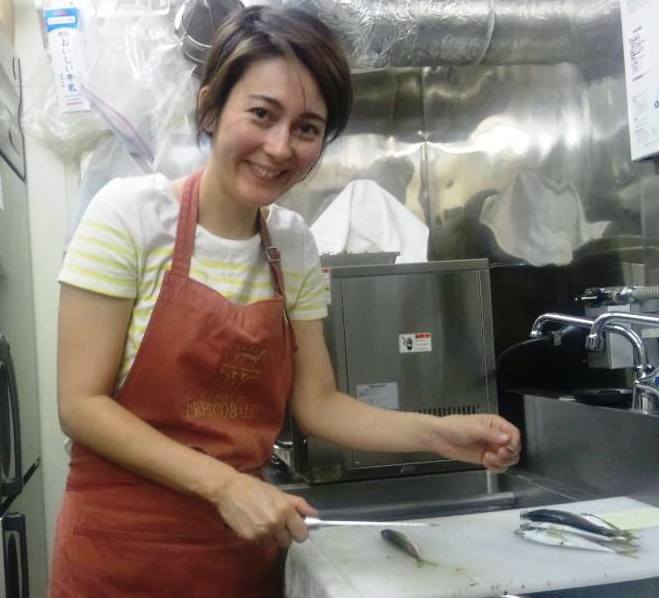
“My three years in Kagawa are my treasure, and I am filled with gratitude towards all the people I was able to meet there”
Everything started with an encounter. After leaving my job in Paris, I was living back with my mother in Strasbourg and was thinking
of working in Japan, where I used to live when I was a child. My mother came back one day from her interpreting job, saying “I met someone who is doing a job that would suit you perfectly.” Oh really?! She had met a Belgian CIR who was on a business trip in our town with a group of colleagues who were interested in the city tram system. So this is how I found out about the JET Programme. I applied and was lucky enough to be sent to Kagawa.
Where is it? I still remember the following phone conversation with my parents. After applying for JET I decided to travel to Tibet, and I was in Lhassa when my parents received a letter with information on my placement. First, my father told me on the phone “You are going to be placed in Kanagawa.” I heard a shuffle on the other side of the line as my mother grabbed the phone. “No, not at all. You are going to be placed in Ka-ga-wa, not in Kanagawa.” My first reaction was “What? But where is Kagawa?” And my mother answered without answering. “Oh, you will be fine. Udon is very good over there and you will be able to ride your bicycle around Takamatsu.” OK… Well, she was right. I did find a very unique udon culture in Kagawa and I also rode my bike every day to IPAL, the Kagawa International Exchange Center, where I worked. But I also ended up meeting many fantastic people and doing many incredible things. My three years in Kagawa brought me so much in terms of experience and joy: they are priceless. Read More
$10K in Matching Funds for Tohoku Relief Still Remains!
 If you’d still like to donate to the Taylor Anderson Memorial Fund (TAMF) in support of Tohoku relief efforts, there’s still time! $10,000 of matching funds remains but will no longer be available in a few days.
If you’d still like to donate to the Taylor Anderson Memorial Fund (TAMF) in support of Tohoku relief efforts, there’s still time! $10,000 of matching funds remains but will no longer be available in a few days.
Donation website: http://www.globalgiving.org/fundraisers/jets-rally-for-tohoku/
The JET/JET Alum community has already come through to an inspiring extent, raising $23,968 for the TAMF through Global Giving. This is already beyond prior expectations, and the Anderson family (which on Thursday attended a showing of “Live Your Dream: The Taylor Anderson Story“at the Council on Foreign Relations which included State Department and Japanese Embassy representatives as well as a strong JETAA DC crew) has been extremely appreciative.
But if you haven’t had a chance to donate yet or you feel like making another donation, please know that for the next day or two matching funds still remain.

Thursday’s showing of “Live Your Dreams: The Taylor Anderson Story” at the Council on Foreign Relations. Those pictured include Andy Anderson (middle), Paige Cottingham-Streater (middle-left), Jim Gannon (right) and JETAA DC’s Joanna Blatchly, Leigh Ann Mastrini, Rebeka Solem, Joy Young, and Paul Champaloux.
Donate for Tohoku on March 11 and Make Your Support TWICE As Effective!
 3/11 Update: FYI, the 24 hour deadline for Global Giving to match donations to the Taylor Anderson Memorial Fund and other 3/11 initiatives has been lifted, and they will continue to match JET contributions until matching funds run out. So JETs/alums can continue to double their donations!
3/11 Update: FYI, the 24 hour deadline for Global Giving to match donations to the Taylor Anderson Memorial Fund and other 3/11 initiatives has been lifted, and they will continue to match JET contributions until matching funds run out. So JETs/alums can continue to double their donations!
*Link to the Global Giving Matching Page: http://www.globalgiving.org/leaderboards/japan-matching-2014/ to see how much various groups are raising.
*Link to the JETAA USA Event Page: https://www.facebook.com/jetaausa
*The link to donate has been added!
Put this on your calendar!
JETAA USA is supporting the Taylor Anderson Memorial Foundation for a 24 hour donation drive that starts when the clock strikes midnight in Japan on March 11. And GlobalGiving has offered to match these donations.
This is a great opportunity to show our ongoing support for Tohoku by going to the Global Giving website on March 11th to make a donation during the matching grant period.
Online donation drive
Donation website: http://www.globalgiving.org/fundraisers/jets-rally-for-tohoku/
Starts: 12:00 midnight Japan time on 3/11 (11 am EST, March 10; 8 am PST, etc)
Ends: 11:59 p.m. Japan time on 3/11 (10:59 am EST on March 10)
Background
Three years have passed since the Great East Japan Earthquake and Tsunami and the devastation in Tohoku has largely faded from the news. However, so much remains to be done for the survivors and TAMF has been partnering with a number of organizations in Japan to provide relief and help the people of Tohoku build a strong and vibrant future.
Smile Together IshinomakiTAMF has provided funding to the following projects:
-
Living Dreams: Tohoku Kids Project
-
Hope for Tomorrow
-
JET Micro Grants
-
Taylor Anderson Reading Corners
-
Taylor Sendai YMCA Scholarships
-
Exchange Programs
For more information on TAMF, please go to http://www.taylorandersonmemorialfund.org/, their Facebook page at https://www.facebook.com/taylorandersonmemorialfund, or watch the NHK interview with Jeanne and Andy at https://vimeo.com/86637051.
JETAA USA is proud to partner with TAMF to carry on the support JETs and JET alumni have shown for Japan and the people of Tohoku ever since March 2011.

Details:
All donations up to $1,000 per individual donor made to the Taylor Anderson Memorial Fund on March 11th Japan time will be matched by Global Giving through their Japan Match Global Giving program. (Global Giving will charge a 15% facilitation fee to cover their costs, which donors may choose to cover if they wish so that their full donation amount goes to TAMF. See the page for details.)
We are also very happy to see Ambassador Kennedy giving her backing to their mission, as well. For coverage of her recent trip to Ishinomaki and visit to Mangokuura Elementary School, where Taylor taught, please check out the article at http://ajw.asahi.com/article/0311disaster/recovery/AJ201311250099.
JQ Magazine: Staying On—JETs in Fukushima Share Their Stories
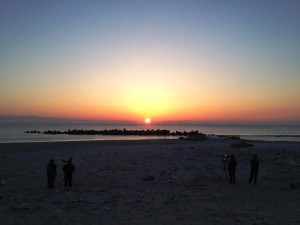
Sunrise over Iwaki: A local pre-dawn commemorative service took place on March 8, 2014, which included taiko performances and ended with the sunrise over the beach near Shinmaikohama Park. (Alexandrea “Xan” Wetherall)
By Eden Law (Fukushima-ken, 2010-11) for JQ magazine. Eden lived and worked in the core city of Iwaki on JET, and he is a current committee member of JETAA NSW, based in Sydney, Australia.
Introduction
It’s been three years since the Great East Japan Earthquake of 2011. While the rest of the world, and arguably, the rest of Japan, has moved on, communities all along the east and north coast continue to endure and deal with the continuing legacy and consequences of that event, especially those displaced from the exclusion zone around TEPCO’s Daiichi plant.
The JET Programme continues to operate, with the government previously announcing plans to double the number of participants over three years. JETs continue to live and work in Tohoku, including JETs who were there before the earthquake, joined later by those placed after 2011. This article will examine the experiences and viewpoints of JETs who continue to work and live in Tohoku, in particular, those living in Iwaki, Fukushima, a city just past the the southern edge of the nuclear exclusion zone. Three years on, they will relate what they’ve seen and observed in their neighbourhood and the city. In addition, the viewpoints of two local Japanese residents will also be included, one from a retired member of a suburb in which evacuees have been housed; and a Japanese English teacher and mother of two.
Before the earthquake, Iwaki was one of the biggest rural cities in Fukushima, with a thriving fishing and farming industry, popular with tourists who come for its natural beauty and well-known beaches. A region rich in history from the Nara period (and prehistory, with its own dinosaur and fossil museums), it also has a famous theme park called the Spa Resort Hawaiians (made famous by the 2006 award-winning film Hula Girls) as well as the Aquamarine Fukushima aquarium. A mere 2.5 hours away from Tokyo by express train, it also supports a large JET community, ideal for those wanting to experience a rural pace with easy access to the bright lights of Tokyo. As a JET placement, it was arguably one of the best places to be.
JET alum Harry Hill named Chairman of U.S. CULCON
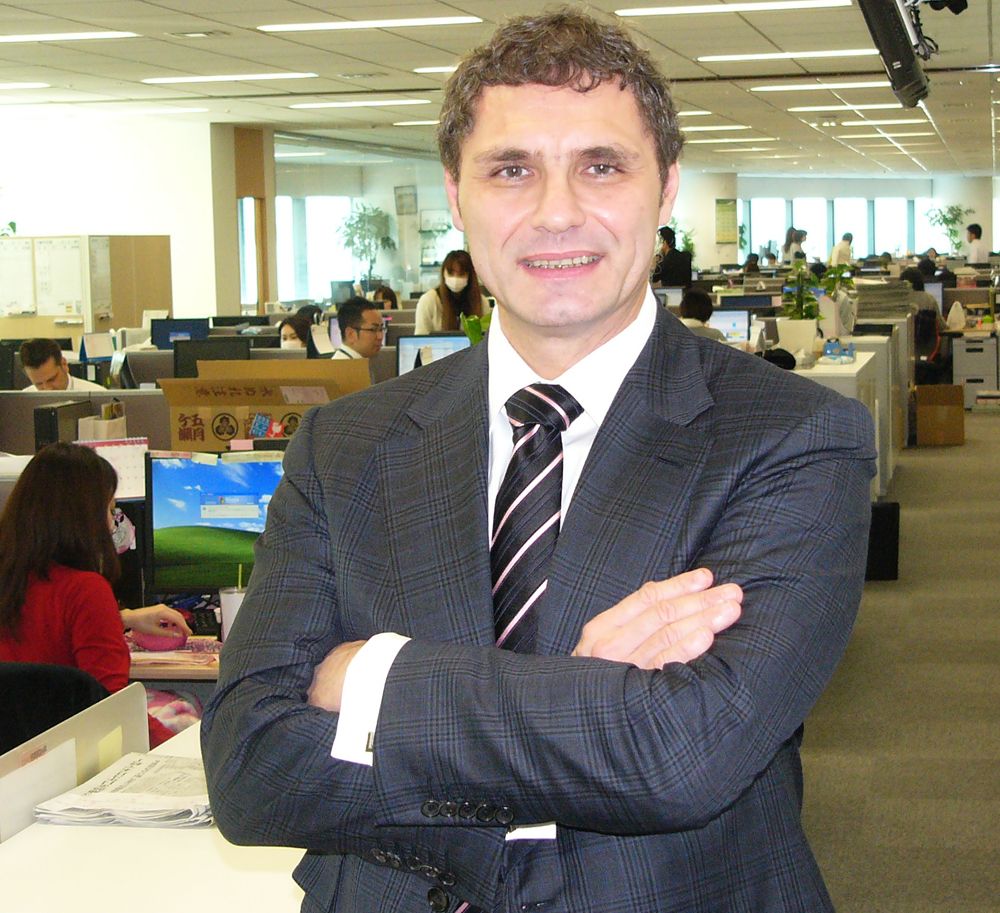 Here’s a link to the official post on the CULCON website: http://culcon.jusfc.gov/news/harry-hill-becomes-chairman-of-u-s-culcon
Here’s a link to the official post on the CULCON website: http://culcon.jusfc.gov/news/harry-hill-becomes-chairman-of-u-s-culcon
FEBRUARY 18, 2014
The Japan-U.S. Friendship Commission and the U.S. CULCON Panel are pleased to announce the appointment of a new Chairman, Mr. Harry A. Hill.
Mr. Hill, a native of New York City, has served as President and CEO of Oak Lawn Marketing, a branding and media company that owns Shop Japan, the largest infomercial brand in Japan, since 2006. He brings with him a wealth of experience related to educational and cultural exchange and entrepreneurship, having lived and worked in Japan for nearly thirty years. Mr. Hill served as a participant on the Japan Exchange and Teaching Programme and its precursor program, the Monbusho English Fellows from 1987-1990 in Gifu Prefecture, where he created a strong network of individuals and government officials who would later help him in building his professional career. His extensive professional experience includes founding H&R Consultants, a leading lease providing and relocation service in Tokyo and Nagoya. In addition, Mr. Hill has been actively involved in numerous charitable and non-profit organizations, including the U.S.-Japan Bridging Foundation, where he has been a member of the Tokyo Advisory Committee and long-time sponsor of its scholarship program. “Mr. Hill will be an asset to the Japan-U.S. Friendship Commission and CULCON, bringing strong leadership experience as a successful entrepreneur, and a deep passion for strengthening the U.S.-Japan relationship through educational and cultural exchange,” says Executive Director Paige Cottingham-Streater. Mr. Hill’s expertise on Japan and cross-cultural communication skills will further advance the Commission and CULCON’s efforts to invest in Japanese and American studies, people-to-people exchanges and artistic and cultural initiatives.
Mr. Hill succeeds Read More
CLAIR Magazine “JET Plaza” Series: Don Brown (Osaka)
Each month, current and former JET participants are featured in the “JET Plaza” section of the CLAIR Forum magazine. The March 2014 edition includes an article by JET alumnus Don Brown. Posted by Celine Castex (Chiba-ken, 2006-11), currently programme coordinator at CLAIR Tokyo.
***********
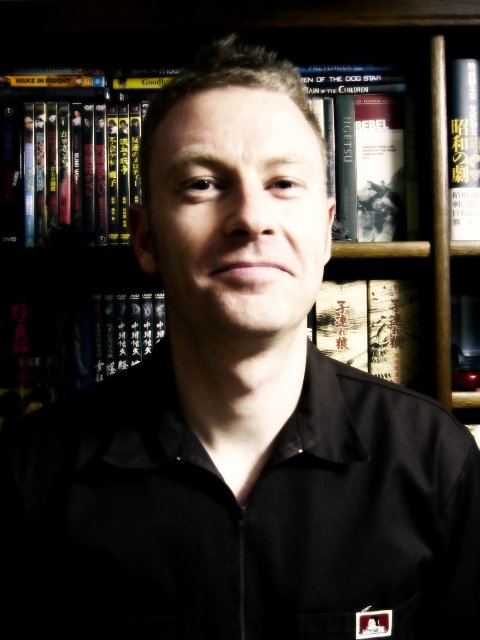
“I’ve been in Japan for 14 years now, but those first three in Kawachinagano were the most thrilling and character-building. Without them, I wouldn’t be where I am now, and thanks to JET, I’m now doing exactly what I always wanted to do.”
Originally from Auckland, New Zealand, Don Brown (Osaka-fu, Kawachinagano-shi, 1999-2002) majored in journalism and Japanese at university and worked in television before taking part in the JET Programme as a CIR. He subsequently remained in Japan and held several jobs including Public Affairs Officer at the New Zealand Embassy in Tokyo before becoming a freelance subtitler and translator specializing in Japanese film. In 2013, films for which he provided English subtitles were screened at the Cannes and Venice film festivals.
20/20 Hindsight
Somehow I doubt that I’m the only JET Programme participant who looks back on their time with regret. Now don’t get me wrong – this isn’t the beginning of some bitter diatribe. When I say regret, I mean along the lines of “I wish I’d spoken to that colleague more,” or “I wish I’d reacted differently in that situation,” or “I wish I’d done more in the time I had.” It wasn’t until my time on the Programme was up that I became fully aware of how lucky I’d been to have lived and worked in Kawachinagano.
No, you can’t ski there. Despite the “nagano” in the name, the city is located in the southeast of Osaka, on the border with Nara and Wakayama. Or as I liked to explain, the heel in Osaka’s boot. 70% of the city is forest (toothpicks and bamboo blinds are its major exports), and it even boasts mountains and a lake, but it’s only about a half-hour train journey away from downtown Namba. Try finding a place to live with those favorable specifications in Tokyo. I couldn’t.
The first time I stepped off the train at Kawachinagano Station on the Nankai Koya line, I instantly had a gut feeling that I was in the right place. My supervisor and a couple of other senior staff members from my division treated me to dinner at a conveyor belt sushi joint, made sure I had everything I needed at my apartment, and even helped me to acquire a bike. At the end of my bewildering first day at the office, the shy junior staff shuffled over to my desk in a tight formation and engaged me in conversation. Pretty soon, they were taking me out to massacre songs in two languages at karaoke and flail away in vain at lethal velocity baseballs at the batting center. Members of the international friendship association welcomed me into their homes and treated me like their long-lost son, only paler and frecklier.
Having never studied in Japan prior to JET, let alone translation and interpreting, being thrown into the deep end forced me to develop skills I still depend on today. It also dispelled all the preconceived notions about Japan and Japanese people that I’d accrued over the years from reading books and watching films back home, and gave me my first revelatory glimpses of what living and working in Japan was really like for flesh-and-blood Japanese people. As well as my colleagues in the cultural division and the international friendship association, my job brought me into contact with people from many and varied walks of life. Teachers and school children, sake brewers, calligraphers, firefighters and police officers, rice farmers, prefectural governors, World Cup organizers, and the diverse local foreign community. Coming from a wee island in Auckland’s Hauraki Gulf with a fluctuating population of only a few thousand, calling my time in Kawachinagano “eye opening” would do the place a gross disservice. “Mushroom-free consciousness expanding” is more like it. Read More
CLAIR Magazine “JET Plaza” series: Jody Maria-Ann Dixon (Yamanashi)
Each month, current and former JET participants are featured in the “JET Plaza” section of the CLAIR Forum magazine. The January 2014 edition includes an article by current JET participant Jody Dixon. Posted by Celine Castex (Chiba-ken, 2006-11), currently programme coordinator at CLAIR Tokyo.
**********

“Internationalization is a reciprocal process. So, whilst the language is seemingly daunting, it holds the key to a side of Japan you are yet to see. Learn the language, and you’ll be amazed at the things it will teach you.”
Originally from Jamaica, Jody Maria-Ann Dixon (Yamanashi-ken, 2009- present) came to Japan for the first time on the JET Programme. The melting pot of cultures and experiences she had daily during her previous job as a Guest Services Manager and Environmental Project Manager at a resort, coupled with her previous academic pursuits (BSc Geography and Geology at the University of the West Indies) were a huge influence on her decision to join the Programme. She has been living and teaching in Fuefuki, Yamanashi, for the past five years and reckons that this experience has engendered a spirit of loyalty; deepened her respect for people and their cultures; and has helped her immensely in making decisions towards her lifelong career goals, which will be centred on international education.
Language and Reciprocity
“If you talk to a man in a language he understands, that goes to his head. If you talk to him in his language, that goes to his heart.” – Nelson Mandela.
“Hello, Konnichiwa!” After four and a half years of walking down my senior high school’s corridors shoulder to shoulder with my Japanese Teachers of English, and hearing this familiar greeting, I am still tremendously appreciative of my students’ use of both English and Japanese interchangeably. Whether they believe that I still don’t understand Japanese (due to my minimal use at school), and they are making an effort to be accommodating; or it is simply an encoded reflex upon catching sight of me, it doesn’t diminish the warmth that the vocalization of a single, friendly, English word evokes.
Upon accepting my placement on the JET Programme, I was honestly blasé about the idea of learning the Japanese language. In my mind, I presumed two things: if it wasn’t a requirement for acceptance, it wasn’t a requirement for “survival,” and; with immersion, the acquisition of Japanese language skills would come easily and naturally. It was indeed sad, the hubris of this English monolingual. Consequently, I arrived in Tokyo in the summer of 2009, and shortly after being welcomed by the beaming faces of fellow foreigners with brightly decorated English placards, I was bombarded with signs, questions, choices and challenges, entirely in Japanese. Though I was to be a resident in this country – for what I didn’t know then, was going to be at least five years – for a moment, (that I didn’t allow to last too long), I was nothing more than a struggling “tourist,” being constantly aided by jovial and obliging individuals using a mixture of a smidgen of English, light speed Japanese, gestures noteworthy of a winning game of charades and a series of begrudging sighs.
No one, especially at the grand old age of 23, wants to feel helpless and illiterate. Whilst I relished being the novel neighbourhood foreigner, and welcomed the polite gestures and formal invitations extended to me, I constantly felt that there was something missing. Though there were always words being exchanged, I was failing horribly at meaningful communication. For a while, I felt cheated. My shortcoming of non-existent Japanese language skills had me teetering on the periphery of all the things life in Japan encompassed. If I wanted to regain my privacy; make connections and friends outside of my Japanese workplace; or indulge in and understand the folklore and traditions, etc. I had to make an effort to acquire some level of Japanese proficiency. I knew I was here to teach English, and perhaps about life in Jamaica if they’d agree, but I also understood very early, that in order to do so effectively, I would have to commit myself unreservedly to learning. Read More
CLAIR Magazine “JET Plaza” series: Marshall Ikeda (Miyagi)
Each month, current and former JET participants are featured in the “JET Plaza” section of the CLAIR Forum magazine. The December 2013 edition includes an article by current JET participant Marshall Ikeda. Posted by Celine Castex (Chiba-ken, 2006-11), currently programme coordinator at CLAIR Tokyo.
**********
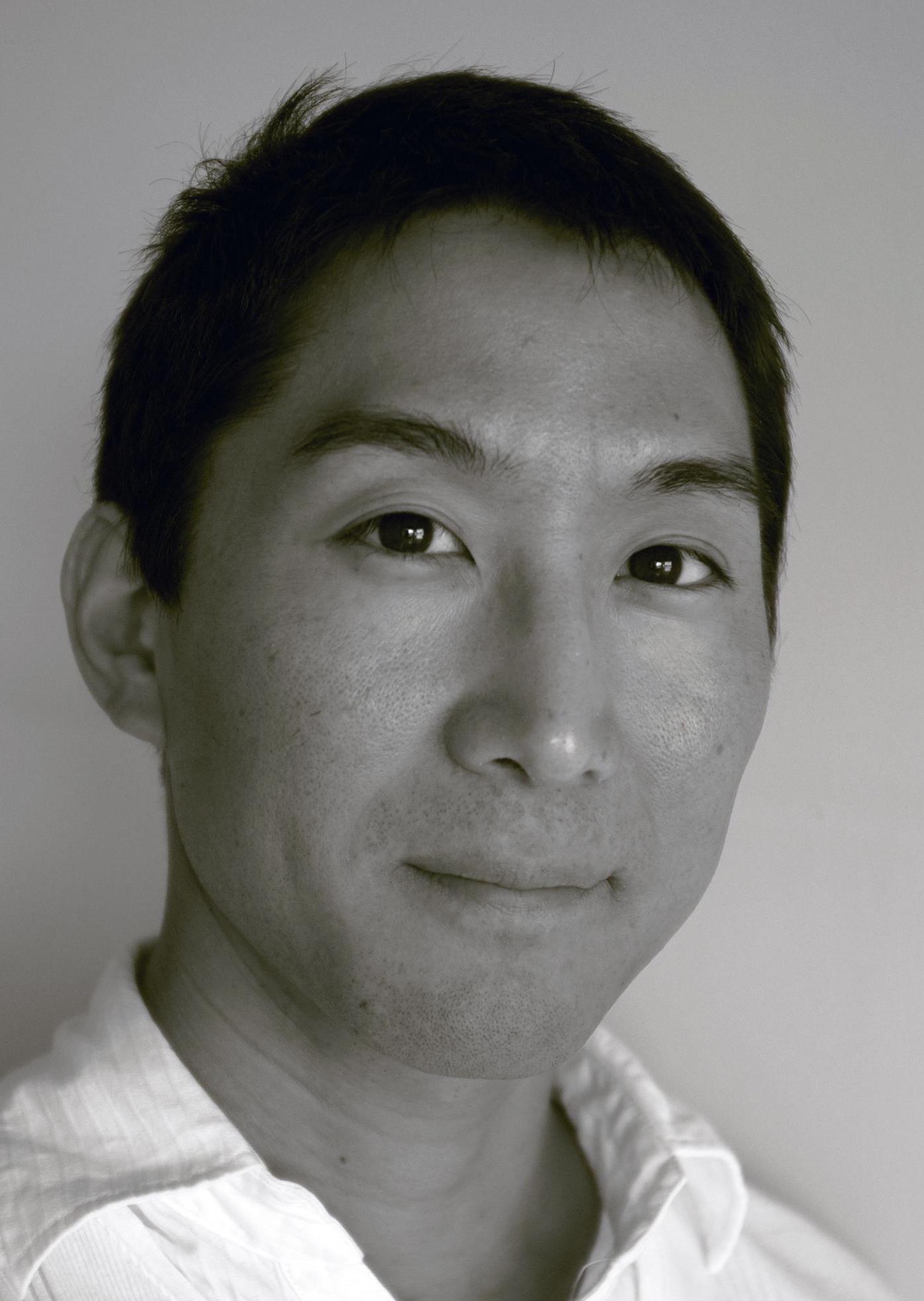
“From the day I set foot in Natori as a JET, I knew it would be a life-altering experience. As cliché as it sounds, I really do feel like [it] is my home away from home.”
Natori My Second Home
It was the heat, humidity and the overpowering sound of cicadas that welcomed me to the city of Natori. Bordering the neighboring city of Sendai, Natori is nestled between a mountain range to the west and Pacific beaches to the east. The mixture of city and country was a perfect combination to satisfy my curiosity and love for travel. After arriving, I began exploring the wonderful aspects of Natori every weekend, and quickly grew to know and love the area.
My commute to three different schools, two Elementary and one junior high, also helped me get acquainted with Natori. My favorite school to visit is an elementary school buried far in the mountains. In order to get there, I have to set out on a hard one-hour bike ride early in the morning. From the time I first arrived, this hour spent outdoors has allowed me to experience the beauty of all four seasons on my way to work. Paired with my time outdoors spent biking, the scenery surrounding Natori has made it easy to integrate the seasons into my classroom activities. In spring we hold classes under the cherry blossoms. In fall we trace Japanese maple leaves onto paper. In winter, we build three-piece snowmen. These experiences represent a unique cultural exchange for my students. I feel fortunate to be able to use my natural surroundings as a teaching aid. As Canada is also rich in natural beauty, it is easy to make ties to my homeland. Infusing nature into my teaching curriculum interests my students academically and culturally.
Despite many successful attempts to incorporate active teaching styles into my lesson plans, the most challenging aspect of teaching English has always been engaging the students. When I first began teaching, I was deluded by an unrealistically positive vision that all students adore English. I soon realized of course that this is simply not true- some students do not even want to try speaking at all! While I cannot force every student to love English, (and I am not expected to), I still try to demonstrate to my students how English is beneficial for travel, work, school, and lifestyle. My efforts in readjusting students’ perceptions of English is certainly not an overnight process, but I believe it is the driving force for myself, and many other ALTs working in Japan.
While it is discouraging at times that some students simply do not show an interest in English, there are always those students willing to go the extra mile. Over the past year, I had the pleasure of coaching one of my junior high students to the finals for the All Japan National Speech contest. Through her consistent time and effort, she was highly successful in her English goals. I feel very rewarded in circumstances where students display a positive attitude towards English, and want to put forth their best efforts. I believe that the most rewarding aspects of being an ALT comes from being able to see tangible results. Read More
CLAIR Magazine “JET Plaza” series: Dr. Adam Komisarof (Saitama)
Each month, current and former JET participants are featured in the “JET Plaza” section of the CLAIR Forum magazine. The February 2014 edition includes an article by JET alumnus Dr. Adam Komisarof. Posted by Celine Castex (Chiba-ken, 2006-11), currently programme coordinator at CLAIR Tokyo.
***********
Adam Komisarof (Saitama-ken, 1990-92), PhD, is a professor in Reitaku University’s Department of Economics and Business Administration. In 2012-13, he served as a senior associate member of St. Antony’s College, Oxford University, and conducted research as a visiting academic at the Nissan Institute of Japanese Studies. As a bilingual intercultural trainer (Japanese and English), he has conducted workshops for thousands of participants in Japan, the United States, Southeast Asia, and Europe. Dr. Komisarof has over 40 publications and has authored two books, On the Front Lines of Forging a Global Society: Japanese and American Coworkers in Japan (2011) and At Home Abroad: Westerners’ Views of Themselves in Japan (2012).

“Overall, my life in Japan has been very satisfying, and if the JET Programme had not given me such a positive first experience here, I doubt that I ever would have settled in Japan and led the life I have. JET has opened my eyes to a new cultural, linguistic, and personal reality for which I am deeply grateful.”
A Life Trajectory Shaped by the JET Programme
My experience in the JET Programme made me who I am today—both as a professional and a human being. When I graduated from Brown University in 1990 and readied myself to journey to Japan, I never imagined that I would be still living here in my middle age, raising a family, and working as an academic who researches and teaches about how culture affects human experience, thought, and behavior. Yet here I am. Currently, I am a professor at Reitaku University, where I teach intercultural communication, English, and acculturation psychology. In my free time, I am also a corporate intercultural communication trainer and consultant. And with the exception of one year of my sabbatical at the University of Oxford, I have lived in Japan continuously since 1998 (in addition to two years on JET from 1990-1992).
So how did I get here? While at Brown, I studied education, so after graduation, I had two goals: to teach English and to do so in a culture that was completely different from my own. I spent the next two years working daily in the same high school in Saitama, a place which I called my “educational laboratory.” The English teachers encouraged me to design our lessons while giving advice and feedback. Consequently, I grew immensely as a teacher during those two years, as I could experiment with many educational philosophies and methods. I also developed close relationships with other teachers since they included me in many social events where we engaged in the revered Japanese custom of “nomunication.” Read More
Kyodo News “JET Alumni” Series: Laura Tasharofi (Kochi)
News agency Kyodo News has recently been publishing monthly articles written by JET alumni who were appointed in rural areas of Japan, as part of promotion for the JET Programme. Below is the English version of the column from January 2014. Posted by Celine Castex (Chiba-ken, 2006-11), currently programme coordinator at CLAIR Tokyo.
*********
Laura Tasharofi (Kochi-ken, Yusuhara-cho, 2004-07) hails from Gold Coast, Queensland, Australia. After a Bachelors Degree in Japanese Studies from Griffith University, Gold Coast, she joined the JET Programme and was placed as a CIR in a little Shikoku town where she spent the next three years. She currently works as the Student Loan Coordinator for Queensland TAFE and has been the President of JETAA Queensland since 2011.
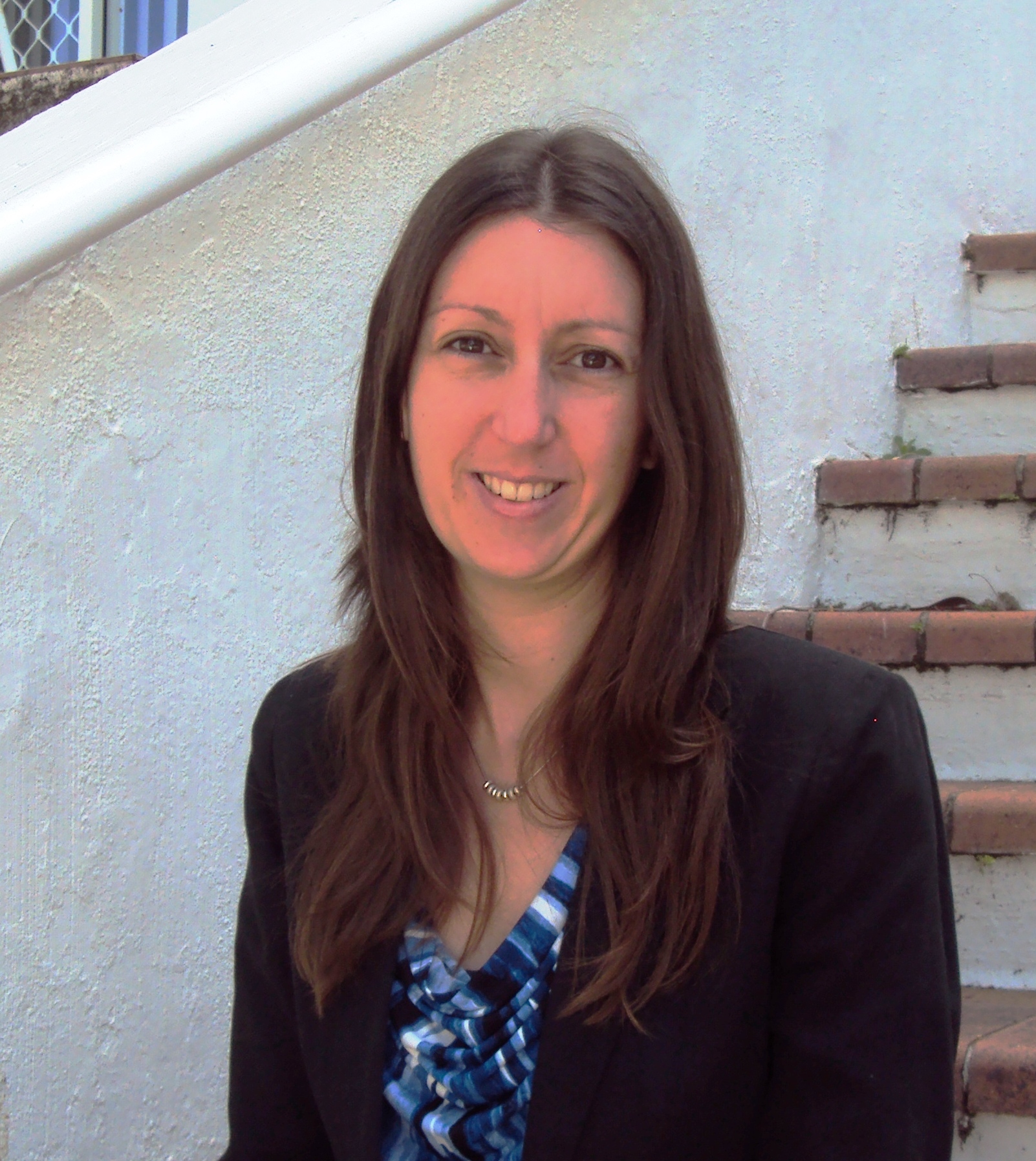
“I always encourage young people I meet to consider the JET Programme as a life experience, and I am eternally grateful for the opportunities the JET Programme gave me.”
The Town Above the Clouds
Yusuhara: Town Above The Clouds (梼原町:雲の上の町). With a slogan like that, I suppose it should have been obvious, but as my supervisor drove me home from Kochi Ryoma Airport, I couldn’t believe how far we were climbing into the mountains. The deep green pine trees were towering over the winding road, and there were wisps of low cloud around us after the rain on that hot, humid day. The scenery was beautiful. Little did I know, I would spend the next three years becoming part of a wonderful community and making life-long friends.
Yusuhara had a population of a little over 4,000 people at that time. It is famous for being on the route that Sakamoto Ryoma took when he made his crusade to bring about the Meiji Restoration. You can follow the signs and walk the ‘Sakamoto Ryoma escape route’ (坂本竜馬 脱藩の道), through the hills to finish in Ehime-ken. It has a beautiful onsen and hotel, a pretty river and it is a short drive to the Tengu Highlands. Such a picturesque place, but there weren’t many tourists in those days. Some time after I left, NHK ran a TV series about the life of Sakamoto Ryoma, and that put Yusuhara on the map as a tourist destination for fans of the show.
In a small town like that, a tall Australian woman like me really stood out. People quickly came to recognise me. Everyone would say ‘good morning’, or ‘hello’ as I travelled to work or walked around town on the weekends. They knew where I lived and which car I drove. I very quickly learned that everyone knew where I was and what I was doing at any given time. At first I felt like I had lost my privacy, but I soon felt very safe and comfortable living in a small, friendly community where everyone knows each other.
I was quite busy as a CIR. I spent a lot of time visiting schools to do cultural and English lessons with kids from kindergarten up to Junior High School. I taught the kids how to play cricket, how to make rocky road (chocolate filled with marshmallows, nuts and cherries), I arranged a letter and Christmas card exchange between some of the students in Yusuhara and students at the school where my mum works in Tasmania. I assisted with the annual overseas study trip for 10 students from our town to our sister school in Queensland. I helped out at town events like the marathon and the kagura taikai (神楽大会). Read More

